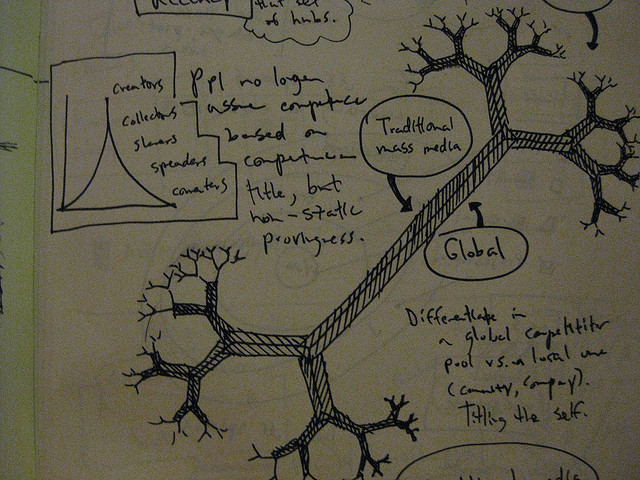Case Study: Scaffolding Outline

OoS: Google Analytics
- Activities addressed in my OoS: Collection, Collation, Processing, Reporting
- GA Data Model: User (Visitor), Session (Visit), Interaction (Hits)
- Data Model Collections and Reports: Dimensions (“descriptive attribute or characteristic of an object”) and Metrics (“Individual elements of a dimension that can be measured as a sum or ratio”) (Google, 2014).
Theories & Selection Rationale
- Ecosystem Ecology (Bateson, 1972/1987; Gibson, 1972/1986; Guattari, 1989/2012; Spellman, 2007)
- Boundaries are difficult to define: Mirrors struggle to define GA boundaries
- Inter-relatedness to neighboring ecosystems: GA connects and measures incoming & outgoing links
- Limits analysis to groups of (rather than individual) living and/or nonliving things: GA only reports aggregated behaviors, even though it collects user data
- Neurobiology (Annenberg Learner, 2013)
- Demonstrates interconnectedness of various nodes and frameworks: GA data model reports metrics interconnected with dimensions to reflect user behaviors; GA also enables both SPCS account and UR roll-up account
- Uses hippocampus as server metaphor: Google data center as input/output hub for GA data collation and processing
- Affirms difference between input and output: GA collects data via data model (input) and reports results via aggregated data tables and visualizations (output)
- Network Society (Castells, 2010)
- Limits analysis to groups rather than individuals: GA only reports aggregated behaviors, even though it collects user data (cf. Ecosystem Ecology, above)
- Addresses movement of data through the network: GA focuses on movement of data from website server (collection) to Google data centers (collation & processing) to administrative accounts (reporting), although this movement is entirely serial rather than parallel
- Provides hierarchy of nodes: GA endows administrators with creative, destructive, and manipulative authority in relation to data; other nodes have far less agency
- Social Network (Deleuze & Guattari, 1980/1987; Scott, 2000; Rainie & Wellman, 2012)
- Recognizes value of social capital in network growth: GA enables measurement of increased or decreased engagement and provides help to increase engagement (social capital)
- Reveals rhizomatic (and unpredictable) character of network connections: GA visualizes network connectivity in myriad visualizations, tables, and downloadable files (which can also be visualized)
- Values growth and sustenance of weaker ties: GA sets up goals that seek to measure and value increased engagement on less-engaging content

User Interfaces, Social Networks: CC licensed image from Flickr user Amber Case.
Similarities
- Focus on flattened network
- Emphasis on rhizomatic rather than hierarchical connections
- Address difficulties of establishing boundaries
- Recognize value of grouping in discussing large-scale network systems
- Focus on nodal groupings rather that individual nodal identities
- Define network as mediator rather than intermediate (Latour, 2005)
Minding the Gaps
- Localization: Neurobiology and Network Society affirm the value and influence of local conditions on global networks that Ecosystem Ecology and Social Network either undervalue or do not address.
- Activity and Flow: Ecosystem Ecology, Neurobiology, and Network Society address movement of data and value across or through the network that Social Network does not directly address.
- Agency: Social Network and Neurobiology ascribe local agency to nodes that Ecosystem Ecology (focused on instinct) and Network Society (focused on hierarchical relationships among managerial elites) do not accept or address.
My Position as Scholar
These theories align with the following statements of my theories of scholarship and pedagogy:
- I embrace the flattened, rhizomatic character of the 21st-century classroom as a (possibly the most) valid model for preparing students for the world of the 21st-century networked workplace.
- I embrace composition as social and situated within a larger global context, and I embrace and value local and global aspects of the composing experience as preparation for both academic scholarship and professional management.
- I embrace scholarship as collaborative and networked, and revel in the breakthroughs made more likely and/or possible through collaborative, rather than individual, scholarship.
- I embrace pedagogy as joining with a group of students in a flattened community of learners in which, to the extent possible, hierarchical teacher-student relationships are replaced by flattened learner-learner relationships.
- I embrace and seek connections between scholarship and utility, between theory and praxis, and between academic and alt-academic pursuits and theorizing.
- I embrace Yagelski’s (2006) “troublemaking collectivity” as a mantra for the disruptive role of my own and my collaborative scholarship and pedagogy in institutions entrenched in antiquated, outdated theoretical paradigms.
- I embrace as vital the role of network activity in learning activities.

U.S Atlantic Seaboard at Night: May 23, 2011. Original image from NASA Earth Observatory.
My Biases and Background
These theories align with my own biases and background in the following ways:
- I am now, and have been since 2000, employed in an alt-academic role as a full-time marketing web manager and part-time adjunct professor of liberal arts and scholar of English studies. This role influences the value I place on connections between theory and praxis, between research and application.
- As former director of a summer residential governor’s school for gifted and talented high school students, I value pedagogical theory and praxis that views standards-based education as little more than a starting point for true academic excellence. This experience influences my preference for network activity in learning activities, especially over standardized assessment tools and products.
- As a professional writer and marketer, I use academic skills like research and collaborative composing in non-academic settings. This experience influences my preference for collaborative, team-based solutions to professional challenges, including audience research.
- As a third culture kid who grew up outside of the U.S., I embrace the global nature of communications, commerce, development, employment, and growth. This experience influences my desire to place local activities and culture within global networks.
- As a web developer, I value and prefer platform- and system-agnostic open-source software solutions over commercial, and especially proprietary, software solutions. This influences my desire to flatten hierarchical structures, especially of proprietary commercial interests, in favor of open-source and open-access models wherever feasible.
- I am a social media marketer. As a result, I value social networks beyond their community-building application; I value them for monetization via targeted advertising. My role as a social media marketer influences my willingness to find value in globally-accessible (but not open-access or open-source) products like Google Analytics while pushing for greater openness and access to these social networking products (see the troublemaking collectivity statement, above).
- I measure web visit data, and my job as web manager exists because I can demonstrate value through higher visit rates, greater visibility across networks, and ultimately higher admissions and enrollment figures. In a professional and continuing studies unit, the value of individual admissions and enrollments is taken very seriously. This experience forces me to work with Google Analytics, which directly influenced by choice of Google Analytics as my object of study. I enter this study with an eye towards providing my team and my administration critical theoretical approaches to data measurement that result in better, clearer communication with prospective and current students.
References
Annenberg Learner. (2013). Neurobiology. Rediscovering biology: Molecular to global perspectives [Online textbook]. Retrieved from http://www.learner.org/courses/biology/units/neuro/index.html
Bateson, G. (1987). Steps to an ecology of mind: Collected essays in anthropology, psychiatry, evolution, and epistemology. Northvale, NJ: Jason Aronson, Inc. Originally published in 1972
Castells, M. (2010). The rise of the network society [2nd edition with a new preface]. Chichester, UK: Wiley-Blackwell.
Deleuze, G., & Guattari, F. (1987). A thousand plateaus: Capitalism and schizophrenia. (B. Massumi, Trans.) Minneapolis, MN: University of Minnesota Press. (Original work published 1980)
Gibson, J. J. (1986). The ecological approach to visual perception. Hillsdale, NJ: Lawrence Erlbaum Associates. Originally published in 1979
Google. (2014). Dimensions and metrics. Google Analytics Help. Retrieved from https://support.google.com/analytics/answer/1033861?hl=en
Guattari, F. (2012). The three ecologies. Trans. Ian Pindar & Paul Sutton. London, UK: Continuum International Publishing Group. Originally published in 1989
Latour, B. (2005). Reassembling the social: An introduction to actor-network-theory. Oxford, UK: Oxford University Press. Clarendon Lectures in Management Studies
Rainie, L., & Wellman, B. (2012). Networked: The new social operating system. Cambridge, MA: MIT Press.
Scott, J. (2000). Social network analysis: A handbook (2nd ed.). Los Angeles, CA: Sage.
Spellman, F. R. (2007). Ecology for nonecologists. Lanham, MD: Government Institutes, 3-23; 61-84.
Yagelski, R. P. (2006). English education. In B. McComiskey (Ed.), English Studies: An Introduction to the Discipline(s) (pp. 275-319). Urbana, IL: NCTE.
[ Feature image: Bamboo Scaffolding, Cambodia. CC licensed image from Flickr user Lorna ]
